
There are over 1,500 species of geckos, each with its own quirks and adaptations. Whether you’re a budding herpetologist or just curious about the little critters you see scurrying around your backyard, learning about geckos can be both fascinating and fun. Let’s dive into some of the most captivating facts about these remarkable reptiles!
1. Geckos Can Stick to Almost Any Surface
One of the most mind-blowing facts about geckos is their ability to stick to walls and even ceilings. How do they do it? Well, their feet are covered in tiny hair-like structures called *setae*. These structures increase the surface area of their toes, allowing them to use the forces of *van der Waals*—a scientific principle of attraction between molecules—to cling onto surfaces.
This means a gecko can effortlessly stroll up a glass window or hang from a ceiling without breaking a sweat. Think about it: it’s like having a superpower for climbing! Geckos can even run across smooth surfaces at impressive speeds. Imagine trying to keep up with one of these little guys as they dart around your home!
2. They Use Their Tails for Balance
Geckos also have impressively flexible tails that serve multiple purposes. Not only do these tails help with balance when they’re climbing and running, but they can also be used as a defense mechanism. If a gecko is threatened, it can lose its tail—a process known as autotomy.
Once the tail is shed, the gecko can make a quick getaway while the tail wriggles around, distracting the predator. The good news is that geckos can regenerate their tails over time, although the new tail might not look exactly the same as the original. Just imagine the surprise of a predator when they realize they’ve been fooled!
3. Geckos Communicate with a Unique Vocabulary
You might think reptiles aren’t exactly chatty, but geckos have a pretty fascinating way of communicating. They use a variety of sounds such as clicks, chirps, and barks to convey messages to one another. Each sound has its own meaning, which can range from warning signals to mating calls.
For instance, male geckos often call out to attract females, making their vocal presence known in their territory. It’s like their own version of a dating app! The variety of sounds and their meanings can depend on the species, adding another layer to their interesting behavior. Next time you hear a gecko, pay close attention—you might just witness a little reptilian conversation!
4. Their Color Can Change
While geckos aren’t as famous for color-changing abilities as chameleons, many species can shift their hues slightly. This isn’t usually for camouflage but rather as a response to temperature, light, and even mood.
For example, a stressed gecko might darken its color to absorb more heat from the sun, while a calm gecko could lighten up. This ability to change color can help them regulate their body temperature or convey emotions, making them even more fascinating. So, just like us, geckos might wear different “clothes” depending on how they feel!
5. Geckos Are Insect Eaters
Geckos are primarily insectivores, which means their diet mainly consists of insects. These little hunters can eat anything from crickets and moths to flies and beetles. Their sharp teeth are perfect for catching and holding onto their slippery prey.
Interestingly, some larger gecko species might munch on small vertebrates or even fruit. Watching a gecko hunt can be quite a sight—it’s like viewing a nature documentary right in your backyard! This diet not only keeps geckos thriving but also helps control insect populations, making them beneficial to local ecosystems.
6. They Don’t Have Eyelids
Here’s a quirky fact: geckos don’t have eyelids! Instead of eyelids, geckos have a transparent membrane called a *spectacle* that covers and protects their eyes. This unique feature actually helps them when they’re climbing and darting about, as they don’t have to worry about their eyelids getting in the way.
To clean and keep their spectacles clear, geckos often lick their eyes with their tongues. It’s a bit of a strange image, but hey, every creature has its own way of doing things! This adaptation shows just how versatile and unique these little reptiles really are.
7. Some Geckos Are Nocturnal
Many geckos take the nightlife quite seriously. Nocturnal species are active at night, taking advantage of the cooler temperatures and the cover of darkness to hunt and socialize. This means you might see them out and about when you’re winding down for the day.
Being nocturnal comes with its own set of adaptations too. For instance, geckos often have large eyes to help them see better in low light conditions. They also possess a special layer of cells in their retinas, which enhances their night vision. So, if you’re ever out in the wild and see a pair of glowing eyes staring back at you, there’s a good chance it’s a curious gecko!
8. Geckos Can Be Found All Over the World
From tropical rainforests to deserts, geckos are truly adaptable creatures. They’re found on almost every continent except Antarctica, which makes them pretty much global citizens of the reptile world.
Different species have evolved to thrive in various environments. For example, some geckos in arid regions have adapted to survive with minimal water, while others in humid areas rely on the abundant moisture. This adaptability showcases not just their resilience but also the wonders of evolution.
9. They Have a Unique Defense Mechanism
In addition to their ability to shed their tails, geckos have another clever trick up their sleeve. Some species can produce a foul-smelling substance from their skin as a defense mechanism against predators. This not-so-pleasant smell can confuse or repel attackers, giving the gecko the chance to escape.
It’s like having a built-in defense spray! Combine this with their speed and agility, and it’s clear that geckos are well-equipped to survive in the wild. Nature has truly given them some impressive tools!
10. Geckos Have a Special Place in Culture
Last but not least, geckos hold significant cultural importance in many parts of the world. In some cultures, they are symbols of good luck or fertility. In others, they are believed to be protectors against evil spirits.
Their distinct appearance and behavior have inspired art and folklore, adding to their allure. You might even find gecko motifs in local crafts and decorations! This cultural significance further emphasizes how intertwined humans and geckos have been throughout history.
In summary, geckos are more than just cute little creatures you might spot in your garden. From their incredible climbing abilities to their unique adaptations, these reptiles are full of surprises. Exploring the world of geckos not only opens a window into the wonders of nature but also reminds us of the beauty and complexity of life on our planet. So, the next time you see a gecko, take a moment to appreciate just how fascinating these little lizards truly are!

